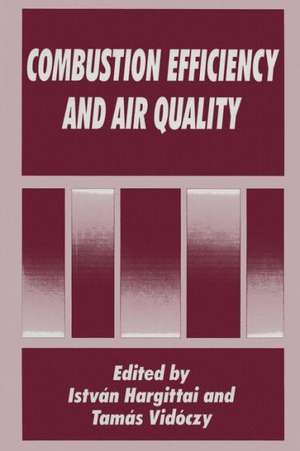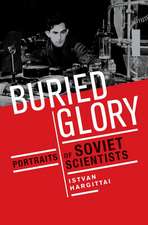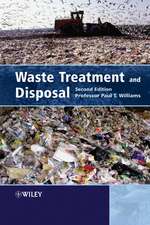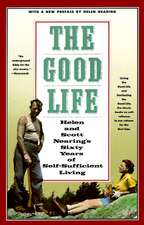Combustion Efficiency and Air Quality
Editat de Istvan Hargittai, T. Vidóczyen Limba Engleză Paperback – 24 oct 2012
Preț: 387.96 lei
Nou
Puncte Express: 582
Preț estimativ în valută:
74.24€ • 80.62$ • 62.37£
74.24€ • 80.62$ • 62.37£
Carte tipărită la comandă
Livrare economică 23 aprilie-07 mai
Preluare comenzi: 021 569.72.76
Specificații
ISBN-13: 9781461357391
ISBN-10: 146135739X
Pagini: 308
Ilustrații: XIII, 289 p.
Dimensiuni: 152 x 229 x 16 mm
Greutate: 0.41 kg
Ediția:Softcover reprint of the original 1st ed. 1995
Editura: Springer Us
Colecția Springer
Locul publicării:New York, NY, United States
ISBN-10: 146135739X
Pagini: 308
Ilustrații: XIII, 289 p.
Dimensiuni: 152 x 229 x 16 mm
Greutate: 0.41 kg
Ediția:Softcover reprint of the original 1st ed. 1995
Editura: Springer Us
Colecția Springer
Locul publicării:New York, NY, United States
Public țintă
ResearchCuprins
1 Models for Environmental and Chemical Systems.- 1. Club of Rome.- 2. Two Examples.- 3. Martin and Golay.- 4. Toth and Garai.- 5. A Play with Three Participants.- 2 Structural Investigation of Molecules of Energetic Materials in the Gas Phase.- 1. Introduction: Aims and Scope.- 2. Oxides of Nitrogen.- 3. Nitric Acid and Nitrates.- 4. Nitramines.- 5. Nonaromatic Cyclic Systems.- 6. Benzene Derivatives.- 7. Conclusions.- References.- 3 Covalent Inorganic Nonmetal Azides.- 1. Introduction.- 2. Preparation.- 3. Structure and Bonding.- 4. Energetics.- 5. Conclusions.- References.- 4 Chemistry of a Burning Propellant Surface.- 1. Introduction.- 2. Experimental Approaches.- 3. “Clean-Burning” Rocket Propellants.- 4. Modification of Burning Rates.- References.- 5 Competitive Reactions of Methyl Radicals in Partial Oxidation of Methane.- 1. Introduction.- 2. Simulation and Evaluation.- 3. Conclusions.- References.- 6 Theoretical Quantum-Mechanical Study of the Soot Formation Process.- 1. Introduction.- 2. Computational Techniques.- 3. Quantum-Mechanical Predictions.- 4. Conclusions.- References.- 7 Clean Combustion Utilizing Fluidized-Bed Boilers.- 1. Introduction.- 2. Fluidized-Bed Firing.- 3. Environmental and Economic Benefits of Hybrid-Fluid Firing.- 4. Transformation of the Boiler at the Ajka Thermal Power Plant with Respect to Firing Technology.- 5. Measurement Results.- 6. Operating Experience.- References.- 8 Aspects of Catalyzed Coal Liquefaction.- 1. Background.- 2. Catalyst Studies.- 3. Kinetics and Mechanism.- 4. Economics and Environment.- References.- 9 Incineration of Waste Solvents Containing Chlorinated Hydrocarbons: Some Critical Remarks.- 1. Introduction.- 2. Problems in the Modeling of Halogenated Waste Solvent Incineration.- 3. Some Observations aboutthe Relationship between Thermodynamic Calculations and the Practice of Toxic Waste Incineration.- 4. Relationship between CO Concentration and Emission of Products of Incomplete Combustion.- 5. Conclusions.- References.- 10 Concentrations of Combustion Particulates in Outdoor and Indoor Environments.- 1. Introduction.- 2. Characterization of Particles.- 3. Principles of Risk Analysis.- 4. The Concept of Total Exposure.- 5. Outdoor Levels of Particulates.- 6. Indoor Levels of Particulates.- 7. Significance of Combustion Particulate Concentrations.- 8. Conclusions.- References.- 11 Bulk and Surface Studies of Fly Ash Particles.- 1. Introduction.- 2. Analytical Techniques.- 3. Experimental Results.- 4. Conclusions.- References.- 12 Polycyclic Aromatic Hydrocarbons: From External to Internal Environments.- 1. Introduction and Scope.- 2. Results and Discussion of Ambient Airborne PAHs.- 3. Routes of Human Exposure to PAHs.- 4. Biomarkers of Human Exposure to PAHs.- References.- 13 Quality of Indoor Air.- 1. Introduction.- 2. Indoor Behavior of SVOCs.- 3. VOCs in an Office Building—A Case Study.- 4. Occurrence of VOCs in Residential Buildings.- 5. Summary.- References.- 14 A Model Framework for Ranking of Measures to Reduce Air Pollution with a Focus on Damage Assessment.- 1. Introduction.- 2. The Oslo Air Study.- 3. Further Methodological Development.- 4. Outline of a Damage Assessment Model.- 5. Conclusions.- References.











